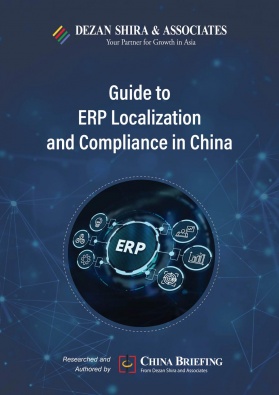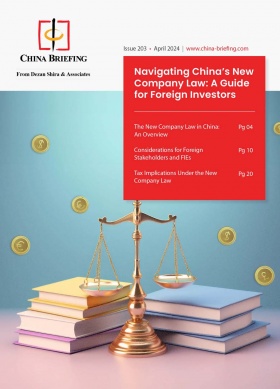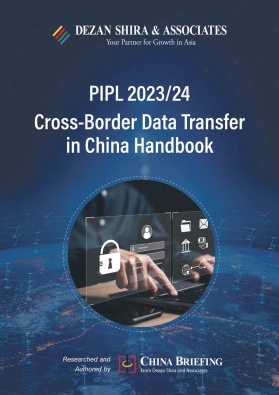Tax Incentives for Manufacturing Companies in China in 2024
China implements a wide range of preferential tax policies to encourage the development of the country’s manufacturing industry. We summarize some of the main manufacturing tax incentives in China and explain the basic eligibility requirements that companies must meet to enjoy them.
China’s Ministry of Finance (MOF) and State Tax Administration (STA) have released guidelines on the main preferential tax and fee policies available to the manufacturing industry in China. The guidelines consolidate the main preferential policies currently in force and explain the main eligibility requirements to enjoy them.
To further assist companies in identifying the preferential policies available to them, we have outlined some of the main policies currently available in the manufacturing industry, including links to further resources.
Value-added tax policies
China provides a range of preferential value-added tax (VAT) policies for manufacturing companies, including VAT exemptions and refunds for the sale of certain products and services.
For instance, VAT is exempted for:
- Taxpayers producing, selling, wholesale, and retail drip irrigation tape and drip irrigation pipe products;
- Taxpayers producing, selling, wholesale, and retail organic fertilizer products; and
- Domestic anti-HIV drugs.
Companies providing the following products and services can enjoy immediate VAT refunds:
- Software products exceeding the tax burden;
- Self-produced new wall materials; and
- Comprehensive utilization of resources products and services.
VAT credit refund policy
Companies in the manufacturing industry that meet the conditions for deferring tax refunds can enjoy a VAT credit refund policy. The policy allows companies to receive the accumulated deferred tax amount every month and the remaining deferred tax amount in a lump sum.
The policy is not exclusive to the manufacturing industry and is also available to companies in scientific research and technical services, utilities production and supply, software and IT services, and many more.
Conditions: To be eligible, taxpayers’ VAT sales generated from business activities in the eligible industries must account for more than 50 percent of the total VAT sales.
In addition, companies must meet the following criteria:
- Have a tax credit rating of A or B;
- Not have any incidents of fraudulent activity related to deferring tax refunds, export tax refunds, or fraudulent issuance of VAT special invoices in the 36 months before the refund application;
- Not have been punished by tax authorities for tax evasion twice or more in the 36 months before the refund application; and
- Not have benefited from the policy of instant refund or deferred payment (refund) since April 1, 2019.
Effective period: The date from which companies can apply for the refund depends on their size:
- Eligible manufacturing companies can apply for a refund of the incremental deferred tax from the April 2022 tax declaration period onwards;
- Eligible medium-sized manufacturing companies can apply for a one-time refund of the remaining deferred tax amount from the July 2022 tax declaration period onwards; and
- Eligible large manufacturing companies can apply for a one-time refund of the remaining deferred tax amount from the October 2022 tax declaration period onwards.
When to apply: Taxpayers applying for deferred tax refunds should apply in the month following the month they meet the conditions for deferring tax refunds. They should complete the VAT tax declaration for the current period within the VAT tax declaration period and then apply for deferred tax refunds.
How to apply: Companies can apply for the refund through online platforms such as the electronic tax bureau or offline at tax service halls. Required documents include the “Tax Refund Application Form” among other relevant materials.
For more information on the VAT credit refund policy, see our article on China’s VAT Rebates Policy: Eligibility, Timeline, and Procedures.
VAT reduction and exemption policies for small-scale taxpayers
There are two key VAT policies for small-scale taxpayers, which also apply to companies in the manufacturing industry:
- VAT exemption policy: Small-scale taxpayers that have monthly sales of RMB 100,000 (US$13,861) or below are exempted from paying VAT.
- VAT reduction policy: VAT small-scale taxpayers subject to a 3 percent tax rate on taxable sales revenue can have VAT levied at a reduced rate of 1 percent. For pre-paid VAT items subject to a 3 percent pre-paid rate, VAT shall be pre-paid at a reduced rate of 1 percent.
Conditions: The sale of real estate is not included in the total VAT-taxable sales. Small-scale taxpayers that have VAT taxable sales exceeding RMB 100,000 in total in a given month, but which do not exceed RMB 100,000 when excluding the sales of real estate, the sales revenue from goods, labor, services, and intangible assets obtained is exempt from VAT.
Individuals and commercial households who obtain rental income from leasing real estate in the form of a one-time rent payment can evenly distribute the income during the corresponding lease period. If the monthly rental income after distribution does not exceed RMB 100,000, VAT will be exempted.
Taxpayers who obtain taxable sales revenue and are eligible for the VAT exemption policy can choose to waive the exemption and issue VAT special invoices for that sales revenue.
Small-scale taxpayers who are subject to the reduced 1 percent tax rate must issue VAT invoices at the 1 percent tax rate. Taxpayers can choose to waive the tax reduction and issue VAT special invoices for that sales revenue.
Small-scale taxpayers who pay taxes at fixed intervals can choose either monthly or quarterly tax periods, and once chosen, cannot be changed within one fiscal year.
Meanwhile, for small-scale taxpayers who are required to prepay VAT according to existing regulations, and whose monthly sales in the prepayment location do not exceed RMB 100,000, no tax payment is required for the current period. If the monthly sales exceed RMB 100,000, the prepayment VAT items subject to a 3 percent prepayment rate shall be prepaid at a reduced rate of 1 percent.
Note that small-scale taxpayers who pay their taxes quarterly can distribute their sales evenly across the three months so that the monthly average sales fall below RMB 100,000 (that is, total sales across the quarter do not exceed RMB 300,000 (US$41,584).
Effective period: January 1, 2023, to December 31, 2027.
When to apply: Small-scale taxpayers should declare corresponding tax obligations in the tax period in which the VAT liability occurs.
How to apply: Small-scale taxpayers can process the tax declaration online through the electronic tax bureau or offline at a tax service hall. When applying for the policy, companies should keep relevant supporting materials for future reference.
For more information on the VAT policies for small-scale taxpayers, see our article on China’s Tax Incentives for Small Businesses.
Preferential corporate income tax (CIT) policies
Reduced 15 percent CIT rate for high-tech companies
High-tech manufacturing companies that are identified as needing key support from the state are eligible for a reduced 15 percent CIT rate, below China’s 25 percent standard CIT rate.
Conditions: To be considered “high-tech”, companies must be resident in the Chinese mainland and be continuously engaged in research, development, and technology transfer within the “National Key Supported High-tech Fields,” have independently formed core intellectual property rights, and conduct business activities based on this.
The “National Key Supported High-tech Fields” are fields that fall under the following categories, per China’s Ministry of Commerce (MOFCOM):
- Electronic information technology
- Biology and new medical technologies
- Aerospace technology
- New material technology
- High-tech services
- New energy and energy-saving technologies
- Resources and environmental technology
- New and advanced technologies for transforming traditional industries
The companies must be certified by the high-tech enterprise recognition management institution composed of the local science and technology administrative departments, finance departments, and tax departments. Companies must have been established and registered for over one year when applying for certification.
Companies must also have acquired ownership of intellectual property rights that play a core supporting role in their main products or services through independent research and development, licensing, gifting, mergers, and other activities.
The technology of the company’s main products or services that plays a core supporting role must fall within the scope specified in the “National Key Supported High-tech Fields.”
The companies must also meet certain staffing, R&D expense, and revenue criteria, which are as follows:
- The proportion of scientific and technical personnel engaged in R&D and related technological innovation activities must comprise at least 10 percent of the company’s total workforce in the current year;
- Total R&D expenses in the past three fiscal years (calculated based on the actual operating period for those that have operated for less than three years) as a percentage of the total sales revenue for the same period must meet the requirement corresponding to their sales revenue, as follows:
- For companies with sales revenue of RMB 50 million (US$6.93 million) or below in the last year, at least 5 percent;
- For companies with sales revenue of between RMB 50 million and RMB 200 million (US$27.72 million) in the last year, at least 4 percent; and
- For companies with sales revenue exceeding RMB 200 million in the last year, at least 3 percent. Of this, at least 60 percent of the total R&D expenses must be incurred in China;
- The proportion of revenue from high-tech products or services in the company’s total revenue for the same period must be at least 60 percent;
- The company’s innovation capacity evaluation must meet the corresponding requirements; and
- The company must not have had any major safety concerns, major quality incidents, or serious environmental violations in the year prior to the application for certification.
Effective period: Indefinite.
When to apply: During monthly and quarterly prepayment declaration of CIT or annual final CIT settlement declarations.
How to apply: Companies can process the tax declaration online through the electronic tax bureau or offline at a tax service hall.
Reduced 15 percent CIT rate in development zones
China provides a reduced 15 percent CIT rate for certain companies that are established in certain areas of the country, including development zones and lesser-developed regions.
These areas are:
- The Western Regions (Inner Mongolia, Guangxi, Chongqing, Sichuan, Guizhou, Yunnan, Tibet, Shaanxi, Gansu, Qinghai, Ningxia, Xinjiang (including the Xinjiang Production and Construction Corps), the Xiangxi Tujia and Miao Autonomous prefectures in Hunan, the Enshi Tujia and Miao Autonomous prefectures in Hubei, Yanbian Korean Autonomous Prefecture in Jilin, and Ganzhou City in Jiangxi);
- The Hainan Free Trade Port;
- The Nansha New Area portion of the Guangdong (China) Pilot Free Trade Zone in Guangzhou;
- The Hetao Shenzhen-Hong Kong Science and Technology Innovation Cooperation Zone in Shenzhen; and
- The Lingang New Area of the China (Shanghai) Pilot Free Trade Zone in Shanghai.
Conditions: To be eligible for the reduced CIT rate, companies must have “substantial operations” within the area in question and be engaged in one of the encouraged industries. Each of the above-listed regions has released its own catalog of encouraged industries.
To qualify for “substantial operations”, companies generally must derive at least 60 percent of their main business income from one of the industries in the respective encouraged lists and have substantial operations within the area.
Effective date: Effective date varies between regions:
- Western Regions: January 1, 2021 to December 31, 2030.
- Hainan Free Trade Port: January 1, 2020, to December 31, 2024 (for companies in encouraged industries). From 2025 onwards, all companies (except those on the Negative List) registered and engaged in substantive operations in the Hainan Free Trade Port will be able to enjoy the 15 percent CIT rate.
- Nansha New Area: January 1, 2022 to December 31, 2026.
- Hetao Shenzhen-Hong Kong Science and Technology Innovation Cooperation Zone: January 1, 2023 to December 31, 2027.
- Lingang New Area: From January 1, 2020.
When to apply: During monthly and quarterly CIT prepayment declarations or annual final CIT settlement declarations.
How to apply: Companies can process the tax declaration online through the electronic tax bureau or offline at a tax service hall.
For more information on the reduced 15 percent CIT rate in select areas, including a full breakdown of the eligibility requirements, see our article on Qualifying for China’s Reduced 15% CIT Rate – Defining “Substantial Operations”.
For more information on tax incentives for technology innovation, see our article on What Are the Tax Incentives in China to Encourage Technology Innovation?
R&D pre-tax super deduction
China’s pre-tax super deduction policy allows resident companies a 200 percent pre-tax deduction of the expenses incurred in conducting research and development (R&D) activities that do not form intangible assets. The policy means that a company that incurs RMB 10 million (US$1.39 million) in R&D expenses in a given year can deduct 100 percent of the expenses incurred in addition to the pre-tax deduction of RMB 10 million that it would already be granted by law, amounting to a total deduction before tax of RMB 20 million (US$2.77 million).
Conditions: Only expenses related to eligible R&D activities can receive the deduction. These include expenses related to systematic activities with clear objectives continuously carried out by enterprises to obtain new scientific and technological knowledge, creatively apply new scientific and technological knowledge, or substantially improve technology, products or services, and processes.
The following activities are not eligible for super deduction:
- Routine upgrades of enterprise products and services.
- The direct application of a scientific research result, such as the direct adoption of publicly available new processes, materials, devices, products, services or knowledge, and so on.
- The technical support activities that companies provide to customers after the commercialization of a product or service.
- Duplication or simple changes to existing products, services, technologies, materials, or processes.
- Market research, efficiency research, or management research.
- Routine quality control, test analysis, repair, and maintenance, or when these activities act as part of an industrial or service process.
- Research in the social sciences, arts, or humanities.
In addition to R&D activities carried out by the company itself, the R&D expenses incurred through commission, cooperation, centralized R&D, and other forms can also enjoy the super deduction.
Meanwhile, expenses related to creative design activities for innovative, creative, or breakthrough products can be subject to additional deductions.
Expenses incurred by a company entrusting an external institution or individual to conduct R&D activities on their behalf are included in the R&D expenses of the company and calculated for additional deduction at 80 percent of the actual amount incurred. The entrusted party, however, cannot be subject to additional deduction again.
Expenses incurred when entrusting an overseas entity with R&D activities will be included in the company’s overseas R&D expenses based on 80 percent of the actual amount of expenses incurred. The portion of overseas R&D expenses that do not exceed two-thirds of the domestic qualifying R&D expenses can be deducted as an additional deduction before CIT. Overseas R&D activities cannot include R&D activities entrusted to overseas individuals.
Effective period: Indefinite.
When to apply: In July and October of the year when the CIT prepayment is made or before May 31 of the following year when the annual final CIT settlement is declared.
How to apply: Companies can process the tax declaration online through the electronic tax bureau or offline at a tax service hall. When applying for the policy, companies should keep relevant supporting materials for future reference.
For more information on the pre-tax R&D super deduction policy, see our article on a Case Study for Qualifying for China’s Pre-Tax Super Deduction for R&D Expenses.
About Us
China Briefing is one of five regional Asia Briefing publications, supported by Dezan Shira & Associates. For a complimentary subscription to China Briefing’s content products, please click here.
Dezan Shira & Associates assists foreign investors into China and has done so since 1992 through offices in Beijing, Tianjin, Dalian, Qingdao, Shanghai, Hangzhou, Ningbo, Suzhou, Guangzhou, Dongguan, Haikou, Zhongshan, Shenzhen, and Hong Kong. We also have offices in Vietnam, Indonesia, Singapore, United States, Germany, Italy, India, and Dubai (UAE) and partner firms assisting foreign investors in The Philippines, Malaysia, Thailand, Bangladesh, and Australia. For assistance in China, please contact the firm at china@dezshira.com or visit our website at www.dezshira.com.
- Previous Article China Reopening After COVID: Latest Developments and Business Advisory
- Next Article








